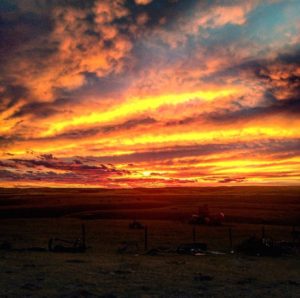
COURTNEY MIRANDA; Social Media & Outreach Coordinator; mirandcs@plu.edu
I grew up in the Gallatin Valley beneath the Big Sky of Montana, where the buffalo still roam and the deer and antelope actually do play.
Fresh and local produce are readily available in abundant supply around Bozeman. The cheapest prices are found at the local grocer who supplies—you guessed it—locally sourced food.
The most popular and, I might be biased, the best restaurants are locally owned and pride themselves on their ‘grow local, eat local, buy local’ policy.
They call us locavores: people whose diet mainly consists of locally grown or produced food.
Visit http://pugetsoundfresh.org for harvest schedules, market locations and more info on supporting local farms.
Recently they’ve purchased and cared for orphan calves—calves rejected or lost by their mothers. Grandpa has a makeshift bottle feeding system in the barn to feed what he refers to as his babies.I am a fifth-generation Montanan. My great-great-grandfather settled on a piece of land in northern Montana and it has stayed in the family since then. My grandparents currently tend to the farm, raise cattle annually and let their enormous Missouri foxtrotter carriage horse, Scooby Doo, pretend he’s one of the cows.

LaFond family ranch
Every year, the grandchildren name each newborn calf, and my grandma refers to each one by their given names.
My grandparents usually have about 7-15 cows in the spring plus about 20-25 orphaned cows. My family butchers a cow only once every two years.
My brother and dad are avid hunters and fishermen, so for the majority of my life, our freezer was fully stocked year-round with elk, venison, beef and fish. The whole family was required to help in the processing of our hunted meat.
That meant butchering it ourselves— which is why I am a gatherer and not a hunter.
I have very distinct and unfortunate memories of hanging and wrapping meat. As gross as it sounds—and actually is—the whole process taught me so much about the importance of good meat.
Coming to Pacific Lutheran University was a particularly difficult diet change. I approached meat very cautiously because I didn’t know where it was from.
I essentially became a vegetarian for my first couple of years at PLU because I wasn’t willing to try the meat. Now that I’m cooking my own meals, it can be very hard to incorporate the protein I need using local meat on a college student budget—and I’m not the only one.
Kait Dawson, a junior at PLU, made the choice to become a vegan the summer before her sophomore year. Being a vegan is often a choice about consuming the right kind of food for your body and the environment. This easily coincides with the principles locavores value, too.

Though organic is a word easily associated with high quality food, Dawson sees past the craze.
“I don’t always buy everything organic. Sometimes it really doesn’t make a difference and it’s just a price markup,” said Dawson.
The best thing you can do for your produce is buying fruits and vegetables in season. “I research what’s in season and I try to eat based on that, like in the fall I eat more corn or pumpkin,” said Dawson. “Stuff that’s harvested in the fall, because you know it’s not being shipped in from places like South America.”
So for those of us who crave watermelon year-round, the best thing you could do for yourself is substitute. Otherwise your watermelon-based diet is most likely lab-produced or grown under very unnatural circumstances.
“I research what’s in season and I try to eat based on that
Dawson does her grocery shopping from a variety of places.
“There’s definitely some planning and thought that goes into it. I buy some things from Fred Meyer, QFC or there’s always Trader Joe’s,” said Dawson.
However, she and her family mainly shop at Harbor Greens in Gig Harbor or in University Place. “They’re very transparent and label where things come from,” said Dawson. “There’s a lot of tricks where something will be labeled ‘fresh Atlantic salmon’ but when you do the research it’s not actually fresh, it’s raised on a farm.”
Kait’s Vegan Banana Bread
Ingredients:
1 3/4 cup of flour
1 1/2 cup of sugar
1 tsp baking soda
1/2 tsp salt
1 cup mashed bananas
1/2 cup of vegetable oil
1/3 cup of soy milk
1 tsp vinegar
2 tsp cinnamon
1/2 cup of applesauce
Preheat oven to 325°. Mix flour, sugar, soda and salt together in a large bowl. Mix bananas, oil, soy milk and vinegar in a medium bowl. Combine banana mixture with dry ingredients. Add the applesauce and cinnamon. Stir well. Pour into a greased 9”x5” bread pan. Bake for 30-40 minutes or until toothpick comes out clean.
In a place as widespread as Tacoma, it can be hard to find affordable local restaurants, especially those sourcing local. If you look hard enough though, they’re out there.
Being a vegan, Dawson is generally drawn towards Asian restaurants because they don’t use a lot of dairy and always have a vegetarian option. “My favorite is Lele’s in Gig Harbor. It’s this Vietnamese restaurant. I love pho and teriyaki places because they can always substitute for tofu,” said Dawson.
Visit http://www.traveltacoma.com/restaurants/local-cuisine/ for local Tacoma restaurants!
So many layers in realm of food consumption exist—no food police will know if your beef was grass-fed and locally raised or if you grew your own potatoes. Because at times simply buying cereal on a college student budget is all that seems manageable. But even taking baby steps can make such a difference for the community and the environment.





















